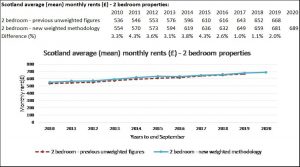Statistics
Calculation of Scotland level average private sector rents – improvements to methodology
November 24, 2020 by Office of the Chief Statistician No Comments | Category Housing
We’re making changes to the way that we calculate average rents at a Scotland level within our annual Private Sector Rent Statistics publication.
Previous approach
In previous publications, the Scotland level average rent figures have been calculated using an unweighted average. Average rent level figures in each area were combined into an overall Scotland figure simply based on the number of records in the underlying rental sample data in each area of the country.
What’s changing?
For the latest publication we have calculated Scotland level figures using a weighted average approach based on separate Scottish Household Survey data on the profile of private rental stock by area and property size over time.
This is to help improve the quality and robustness of the national average rent figures. It will help to ensure that the national average figures presented better reflect changes to the underlying composition of private rental properties over time, and to minimise any effects of changes to sample numbers achieved for particular property sizes or areas in any given years.
Other publication figures on average rents at an area level have been unaffected by this change.
Further details on the weights used
Stock based weights for rented properties have been derived from Scottish Household Survey data, using 3 year rolling data periods. Each 3 year data period has been centred on the rental year to be estimated, with a lag applied of 2 years, due to the time delay between 3 year survey results being available and the latest rental year in question.
For each main property size category (by number of bedrooms), the stock based weights are based on the proportion of private rented households of each size that are located in each of the 18 ‘Broad Rental Market Areas’, using an approximate local authority to rental market area mapping.
For 1 bedroom shared properties (i.e. rooms rented in shared accommodation) the weightings are instead based on the estimated proportions of owner occupier or private rented households in each area that contain two or more adults who are not related or who are not in a married / civil partnership or a co-habiting partnership. This is with the aim to identify the number of households in each area where there may be an individual room being rented in some form.
Further details are available in the publication in Annex D, which provides a full Revisions Note on these methodological changes.
What impact has this had on the figures?
Whilst the use of weights changes some of the individual year average figures compared to the previous unweighted figures, the overall trends over time broadly remain similar for each property size category.
For 2 bedroom properties, the most common size of property in the private rented sector, the weighted figures are slightly higher than previously published unweighted figures across each year 2010 to 2019, with an average annual difference of 2.9%, see chart below.
This slight increase in average rent levels when using the new methodology can be accounted for by some areas having a higher “weight” in the calculations when compared to the previous unweighted average, and where these areas have higher than average rent levels, for example in the Lothian area.
We welcome your views and feedback on this change, and you can email us at housingstatistics@gov.scot
Tags: data, publication, Scottish Government, statistics


Leave a comment
You must be logged in to post a comment.